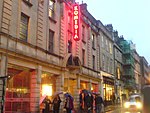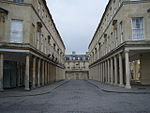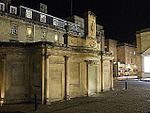Bath city walls
City walls in the United KingdomGrade II listed buildings in Bath, SomersetRoman town of BathScheduled monuments in Bath and North East Somerset

Bath's city walls (also referred to as borough walls) were a sequence of defensive structures built around the city of Bath in England. Roman in origin, then restored by the Anglo-Saxons, and later strengthened in the High medieval period, the walls formed a complete circuit, covering the historic core of the modern city, an area of approximately 23 acres (9.3 ha) including the Roman Baths and medieval Bath Abbey. In the present-day however, the walls have largely disappeared, though the route they took is evident from the street layout; one of the gates partially remains.
Excerpt from the Wikipedia article Bath city walls (License: CC BY-SA 3.0, Authors, Images).Bath city walls
Trim Street, Bath Kingsmead
Geographical coordinates (GPS) Address Nearby Places Show on map
Geographical coordinates (GPS)
| Latitude | Longitude |
|---|---|
| N 51.3825028 ° | E -2.3614444 ° |
Address
12 Trim Street
Trim Street 12
BA1 1HB Bath, Kingsmead
England, United Kingdom
Open on Google Maps










